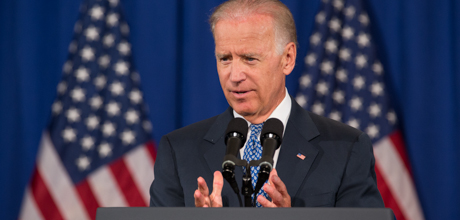The economic success of Asia is fundamentally linked to the U.S., Vice President Joe Biden said at an event hosted by the Center for American Progress (CAP) in the Jack Morton Auditorium last Thursday. His address, which focused on the Obama administration’s effort to strengthen relations with the Asia-Pacific region, took place a week before Mr. Biden visits India and Singapore.
The event opened with a brief welcome from George Washington University President Steven Knapp, followed by Rich Verma, a senior fellow at CAP. CAP President Neera Tanden provided introductory remarks before inviting Mr. Biden to the stage.
In his address, the vice president explained the U.S. is rebalancing its attention and resources toward the Asia-Pacific because the region’s promising economy—which includes a middle class of 1 billion people and fast-emerging markets—has the potential to generate growth around the world, including in the U.S. A recent free trade agreement with South Korea, negotiations to create the Trans-Pacific Partnership (TPP) and strides toward improving relations with China are part of the U.S. effort to foster closer ties with Asia and the Pacific.
Building a healthy relationship will involve “strengthening our alliances, deepening security partnerships and investing like never before in regional institutions to help manage disputes peacefully,” Mr. Biden said.
His upcoming trips to India and Singapore show a commitment to this rebalancing policy. India’s increased engagement and economic growth in Southeast Asia present an opportunity for the U.S. to develop new trade and transportation, while Singapore has an economy ranked the 17th largest in the world. Cooperation with other emerging countries in Southeast Asia is supported through efforts like President Obama’s Expanded Economic Engagement Initiative with the Association of Southeast Asian Nations (ASEAN).
The Western Hemisphere has a role to play, too: Western countries are involved in the TPP and the Pacific Alliance—two efforts to bring countries closer together. The TPP, if successful, will account for 40 percent of the world’s GDP, and it has the potential to set new standards for fair competition. Mr. Biden hopes the partnership will go into effect this year.
When he addressed America’s relationship with China moving forward, he predicted it will not involve conflict, but simply “a healthy mix of competition and cooperation.”
Pivoting toward the Asia-Pacific is going to involve challenges, Mr. Biden explained, among them addressing climate change. He noted the U.S. will work with ASEAN to promote clean energy, help Pacific nations mitigate the effects of rising sea levels and conclude an agreement with China to reduce hydrofluorocarbon pollutants.
Mr. Biden also discussed reducing intimidation and maritime disputes because “economic growth critically depends on peace and stability.” The U.S. looks to China and ASEAN as they work on a code of conduct agreement for the South China Sea. In response to recent “provocative behavior” from North Korea, Mr. Biden said the U.S. welcomes dialogue “if North Korea is prepared to engage in genuine negotiations.”
Despite the new focus on the Asia-Pacific region, Mr. Biden insisted the U.S. will not abandon relationships with Europe or neglect its watch over the Middle East.
“To use the vernacular, we can walk and chew gum at the same time,” he said. “That’s what big powers do.”
Achieving this is possible because “we’re better positioned than any time before to be able to do it all… America is back,” he said, listing 7.2 million new jobs created since 2009 and increases in manufacturing as evidence. He also pointed out the resiliency of Americans, who he said achieve innovation by learning to challenge orthodoxy.
“The president and I are going to continue to reach across the ocean, both east and west, particularly to the indispensable Pacific nations, to help shape a prosperous future for America, for their people and, I would argue, for the world,” Mr. Biden concluded.


